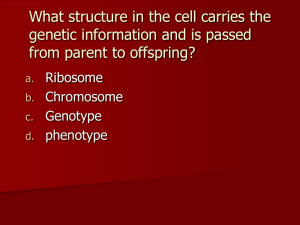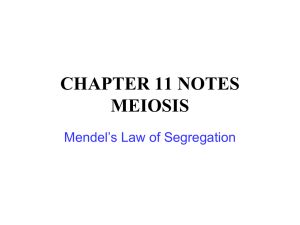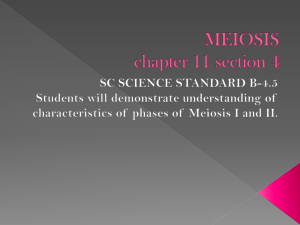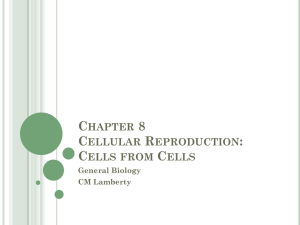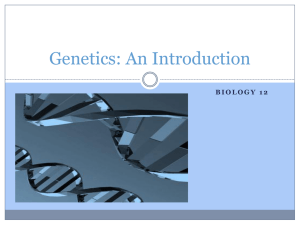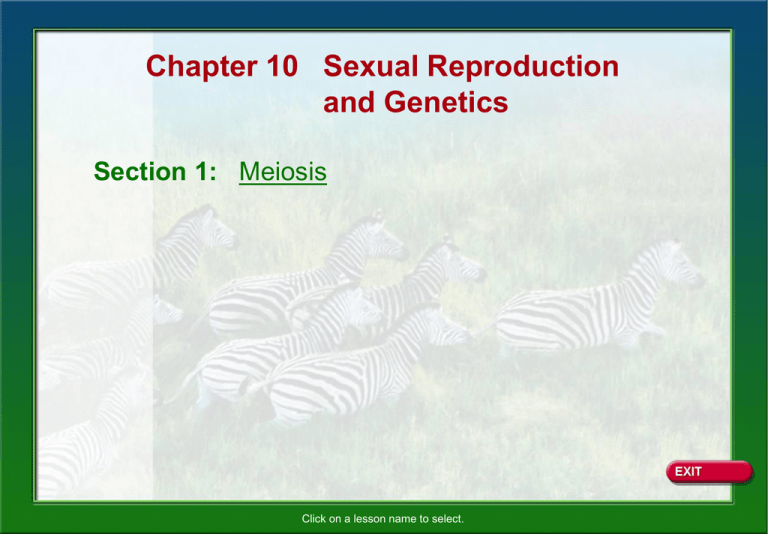
Chapter 10 Sexual Reproduction
and Genetics
Section 1: Meiosis
Click on a lesson name to select.
Chapter 10
Sexual Reproduction and Genetics
10.1 Meiosis
Chromosomes and Chromosome Number
Chromosomes – structures that carry genetic
information from one generation to the next.
Homologous chromosomes— chromosomes
that carry information for the same genes,
not necessarily the same information, but for
the same gene.
Same length
Same centromere position
Carry genes that control
the same inherited traits
Chapter 10
Sexual Reproduction and Genetics
Human body cells have 46 chromosomes, 23 pairs
Each pair has 1 chromosome from each parent
From male parent
From female parent
Gene controlling
ear lobes
Gene controlling
ear lobes
Info - attached
Info - unattached
Gene controlling
chin shape
Info – cleft chin
Gene controlling
chin shape
Info – non-cleft chin
Chapter 10
Sexual Reproduction and Genetics
Haploid and Diploid Cells
Haploid cell - contains only 1 chromosome from each
pair; chromosome number = n
Ex. Sex cells (gametes) egg and sperm
Human gametes contain 23 chromosomes.
Diploid cell - contains both chromosomes from each
pair; chromosomes number = 2n
Ex. Skin cells, liver cells, muscle cells, etc.
Chapter 10
Sexual Reproduction and Genetics
Meiosis
sexual life cycles involve
meiosis.
Meiosis produces haploid
gametes
with half the # of chromosomes
When gametes combine in
fertilization, the diploid number of
chromosomes is restored.
Chapter 10
Sexual Reproduction and Genetics
Meiosis
has 2 consecutive nuclear divisions
Meiosis I
and
Meiosis II
During interphase before
meiosis I, chromosomes
replicate
Chapter 10
Sexual Reproduction and Genetics
Prophase I
Pairing of homologous chromosomes
each consisting of 2 chromatids
Crossing over—chromosomal segments
are exchanged between homologous
pairs. Allows for genetic variation.
Chapter 10
Sexual Reproduction and Genetics
Metaphase I
spindle fibers, which are attached to
centromeres, line up homologous chromosomes
at the equatorial plate
Chapter 10
Sexual Reproduction and Genetics
Anaphase I
homologous pairs separate and begin moving
toward opposite poles
Chapter 10
Sexual Reproduction and Genetics
Telophase I
spindles break down
chromosomes uncoil and form two nuclei
cell membrane pinches in
Cytokinesis occurs producing two new cells,
each with ½ the number of chromosomes of
the original cell….reduction division!!!!
Important – THERE IS NO DNA REPLICATION
BETWEEN MEIOSIS I AND MEIOSIS II.
Chapter 10
Sexual Reproduction and Genetics
Meiosis II
Prophase II
•Chromosomes condense and spindle forms
Chapter 10
Sexual Reproduction and Genetics
Metaphase II
• centromeres that are attached to
spindle fibers line up at the equator.
Chapter 10
Sexual Reproduction and Genetics
Anaphase II
sister chromatids separate at the centromeres
and begin moving toward opposite poles of the cell.
Chapter 10
Sexual Reproduction and Genetics
Telophase II
•chromosomes reach the poles
•nuclear membrane and nuclei reform
Chapter 10
Sexual Reproduction and Genetics
Cytokinesis results in four haploid cells,
each with n number of chromosomes.
Chapter 10
Sexual Reproduction and Genetics
Chapter 10
Sexual Reproduction and Genetics
Meiosis Provides Variation
Depending on how the
chromosomes line up at the
equator, four gametes with
four different combinations
of chromosomes can result.
Genetic variation occurs
during crossing over and
during fertilization, when
gametes randomly combine.
Chapter 10
Sexual Reproduction and Genetics
Sexual Reproduction vs. Asexual Reproduction
Asexual reproduction – new organism inherits all
of it’s chromosomes from a single parent and is
genetically identical to it’s parent
Sexual reproduction - new organism inherits it’s
chromosomes from 2 different parents which
allows for genetic variation
Chapter 10
Sexual Reproduction and Genetics
Chapter Diagnostic
Questions
Which symbol is used to represent the
number of chromosomes in a gamete?
A. #
B. x
C. r
D. n
1.
2.
3.
4.
0%
A
0%
B
A
B
C
D
0%
C
0%
D
Chapter 10
Sexual Reproduction and Genetics
10.1 Formative
Questions
Segments of DNA that control the production
of proteins are called _______.
A. chromatids
B. chromosomes
C. genes
D. traits
1.
2.
3.
4.
0%
A
0%
B
A
B
C
D
0%
C
0%
D
Chapter 10
Sexual Reproduction and Genetics
10.1 Formative
Questions
What is the term for a pair of chromosomes
that have the same length, same centromere
position, and carry genes that control the same
traits?
1.
2.
3.
4.
0%
C
0%
B
A
0%
A
B
C
D
0%
D
A. diploid
B. heterozygous
C. homozygous
D. homologous
Chapter 10
Sexual Reproduction and Genetics
10.1 Formative
Questions
How does the number of chromosomes in gametes
compare with the number of chromosomes in body
cells?
A. Gametes have 1/4 the
number of chromosomes.
B. Gametes have 1/2 the
number of chromosomes.
C. Gametes have the same
number of chromosomes.
D. Gametes have twice as
many chromosomes.
1.
2.
3.
4.
0%
A
0%
B
A
B
C
D
0%
C
0%
D
Chapter 10
Sexual Reproduction and Genetics
10.1 Formative
Questions
What type of organisms only reproduce
asexually?
A. bacteria
B. protists
C. plants
D. simple animals
1.
2.
3.
4.
0%
A
0%
B
A
B
C
D
0%
C
0%
D
Chapter 10
Sexual Reproduction and Genetics
Chapter Assessment
Questions
How many chromosomes would a cell have
during metaphase I of meiosis if it has 12
chromosomes during interphase?
1.
2.
3.
4.
0%
C
0%
B
A
0%
A
B
C
D
0%
D
A. 6
B. 12
C. 24
D. 36
Chapter 10
Sexual Reproduction and Genetics
Chapter Assessment
Questions
Which stage of meiosis
is illustrated?
A. prophase I
B. interphase
C. anaphase I
D. anaphase II
1.
2.
3.
4.
0%
D
0%
C
0%
B
A
0%
A
B
C
D
Chapter 10
Sexual Reproduction and Genetics
Chapter Assessment
Questions
What is the next step for the
chromosomes illustrated?
A. Chromosomes replicate.
B. Chromosomes move to
opposite poles.
0%
0%
C
A
0%
B
D. Chromosomes line up
at the equator.
A
B
C
D
0%
D
1.
2.
3.
4.
C. Chromosomes uncoil
and form two nuclei.
Chapter 10
Sexual Reproduction and Genetics
Standardized Test
Practice
What is this process called?
1.
2.
3.
4.
0%
C
0%
B
A
0%
A
B
C
D
0%
D
A. fertilization
B. gamete formation
C. inheritance
D. reproduction
Chapter 10
Sexual Reproduction and Genetics
Standardized Test
Practice
Before meiosis I, the sister chromatids
of this chromosome were identical.
What process caused a change in a
section of one chromatid?
1.
2.
3.
4.
0%
C
0%
B
0%
A
B
C
D
0%
D
DNA replication
crossing over
synapsis
telophase
A
A.
B.
C.
D.
Chapter 10
Sexual Reproduction and Genetics
Standardized Test
Practice
At what stage is the chromosome
number reduced from 2n to n?
A. prophase I
B. metaphase I
C. anaphase I
D. meiosis II
1.
2.
3.
4.
0%
D
0%
C
0%
B
A
0%
A
B
C
D
Chapter 10
Sexual Reproduction and Genetics
Standardized Test
Practice
To which step in this
process does the law
of segregation apply?
1.
2.
3.
4.
0%
C
0%
B
A
0%
A
B
C
D
0%
D
A. grows into plant
B. gamete formation
C. fertilization
D. seed development
Chapter 10
Sexual Reproduction and Genetics
Vocabulary
Section 1
gene
meiosis
homologous
crossing over
chromosome
gamete
haploid
fertilization
diploid
Chapter 10
Sexual Reproduction and Genetics
Animation
Visualizing Meiosis I and Meiosis II
Generations



